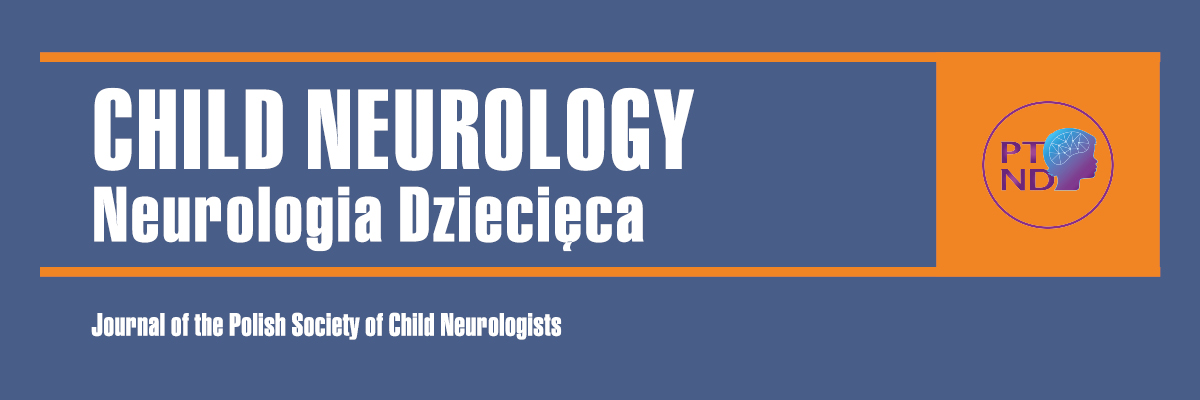Vitamin B12 deficiency encephalopaty as a potentially reversible brain injury — case study based on several years of a patient’s observation
Abstract
Vitamin B12 is one of the neurotropic vitamins that are key to the proper functioning of the nervous system. It participates in the metabolism of nucleic acids, the synthesis of DNA and biogenic amines, and is also necessary in the transformation of fats resulting, among other things, in an effective process of myelinisation. In severe cases, vitamin B12 deficiency, regardless of the cause, leads to the onset of symptoms from the nervous and hematopoietic systems, as well as to psychiatric symptoms. The most common neurological disorders in infants and small children include: retardation of psychomotor development, progressive weakness, muscle hypotonia, hyporeflexia, tremors, convulsions, ataxia, psychomotor regression. The following article presents the diagnostic and therapeutic process and long-term results of treatment of an 11-month-old boy with symptoms of encephalopathy caused by vitamin B12 deficiency. The diagnostics of encephalopathy in infants and small children should take into account deficiency-related, potentially reversible causes, due to the possibility of rapid and effective treatment to prevent persistent neurological problems.
Keywords: cobalaminvitamin B12 deficiencyneurological symptomshypotoniahomocysteineinfant
References
- Mayes P. Struktura i funkcja witamin rozpuszczalnych w wodzie. In: Murray R. ed. Biochemia Harpera. PZWL, Warszawa 1994.
- Rasmussen SA, Fernhoff PM, Scanlon KS. Vitamin B12 deficiency in children and adolescents. J Pediatr. 2001; 138(1): 10–17.
- Dembińska-Kieć A, Naskalski JW. Podstawy diagnostyki hematologicznej. In: Dembińska-Kieć A, Naskalski JW. ed. Diagnostyka laboratoryjna z elementami biochemii klinicznej. Elsevier Urban & Partner, Wrocław 2010.
- Yenicesu I. Pancytopenia due to vitamin B12 deficiecy in a breast-fed infant. Pediatr Hematol Oncol. 2008; 25(4): 365–367.
- Ochocka M, Matysiak M. Niedokrwistość z niedoboru witaminy B12. In: Ochocka M, Matysiak M. ed. Niedokrwistości wieku dziecięcego. PZWL, Warszawa 2000.
- Molloy AM, Kirke PN, Brody LC, et al. Effects of folate and vitamin B12 deficiencies during pregnancy on fetal, infant, and child development. Food Nutr Bull. 2008; 29(2 Suppl): S101–11; discussion S112.
- Chalouhi C, Faesch S, Anthoine-Milhomme MC, et al. Neurological consequences of vitamin B12 deficiency and its treatment. Pediatr Emerg Care. 2008; 24(8): 538–541.
- Graham SM, Arvela OM, Wise GA. Long-term neurologic consequences of nutritional vitamin B12 deficiency in infants. J Pediatr. 1992; 121(5 Pt 1): 710–714.
- Banka S, Roberts R, Plews D, et al. Early diagnosis and treatment of cobalamin deficiency of infancy owing to occult maternal pernicious anemia. J Pediatr Hematol Oncol. 2010; 32(4): 319–322.
- Yakut M, Ustün Y, Kabaçam G, et al. Serum vitamin B12 and folate status in patients with inflammatory bowel diseases. Eur J Intern Med. 2010; 21(4): 320–323.
- Watkins D, Rosenblatt DS. Inborn errors of cobalamin absorption and metabolism. Am J Med Genet C Semin Med Genet. 2011; 157C(1): 33–44.
- Andersen CB, Madsen M, Storm T, et al. Structural basis for receptor recognition of vitamin-B(12)-intrinsic factor complexes. Nature. 2010; 464(7287): 445–448.
- Reynolds E. Vitamin B12, folic acid, and the nervous system. Lancet Neurol. 2006; 5(11): 949–960.
- Briani C, Dalla Torre C, Citton V, et al. Cobalamin deficiency: clinical picture and radiological findings. Nutrients. 2013; 5(11): 4521–4539.
- Scott JM, Molloy AM. The discovery of vitamin B(12). Ann Nutr Metab. 2012; 61(3): 239–245.
- Pietrzik K, Brönstrup A. Vitamins B12, B6 and folate as determinants of homocysteine concentration in the healthy population. Eur J Pediatr. 1998; 157 Suppl 2: S135–S138.
- Mares P, Folbergrová J, Langmeier M, et al. Convulsant action of D,L-homocysteic acid and its stereoisomers in immature rats. Epilepsia. 1997; 38(7): 767–776.
- Lipton SA, Kim WK, Choi YB, et al. Neurotoxicity associated with dual actions of homocysteine at the N-methyl-D-aspartate receptor. Proc Natl Acad Sci U S A. 1997; 94(11): 5923–5928.
- Rush EC, Katre P, Yajnik CS. Vitamin B12: one carbon metabolism, fetal growth and programming for chronic disease. Eur J Clin Nutr. 2014; 68(1): 2–7.
- Lövblad K, Ramelli G, Remonda L, et al. Retardation of myelination due to dietary vitamin B12 deficiency: cranial MRI findings. Pediatr Radiol. 1997; 27(2): 155–158.





